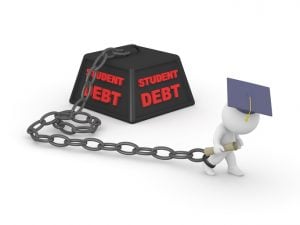[ad_1]

(Photo via iStock)
2022 was a year of fear, uncertainty, and doubt when it came to student loans. After two years of payment and interest freezes on federal loans, borrowers were worried about payments restarting. Numerous articles cite that it will lead to defaults, garnishments, and primarily affect marginalized groups. While student loan forgiveness was a campaign promise made by Joe Biden in 2020, he did not actually release his plan until a few months before the midterm elections, possibly knowing that the plan would be challenged in court.
The moratorium and loan forgiveness (assuming it survives a court challenge) only applied to federal loans. But some borrowers have loans that may not be held by the federal government. This has led to different treatment for borrowers. Let’s look at which group of borrowers benefited the most and the least from this moratorium.
I’ll start with the clear winner which is anyone enrolled in the Public Service Loan Forgiveness program. They finished one-fifth of their 10-year service requirement without making payments. In addition, those who applied for the now-expired limited PSLF waiver or the Temporary Expanded PSLF programs last year received additional benefits, such as past payments being credited which were ineligible for PSLF at the time the payments were made.
Close behind is anyone in an income based repayment (IBR) program who plan to stay on the program until they are eligible for loan forgiveness. They also got at least two years of payment credit without making a payment. But many of them will still have a long way to go before they are eligible for loan forgiveness. And if their financial situation improves, they might no longer qualify for an IBR plan.
Another group of people who benefited from the moratorium are those who continued to make payments even through they are not required to. To them, this is the zero percent interest opportunity they have been waiting for, and their payments will apply exclusively to principal. Once interest accrual resumes, the accrual amount should be a lot smaller than what it was before the moratorium.
The next group of people are those are (or were) in a now defunct federal loan program known as the Federal Family Education Loan (FFEL). While a small number of them are similar to the federal direct loans available today, most were held and serviced by a private entity. These commercially held loans were not eligible for the student loan moratorium and the president’s loan forgiveness program although they could be eligible if they consolidated them to a direct loan.
Some of these FFEL holders had a dilemma. If they consolidate their loans to get the moratorium benefits, they may have to agree to a higher interest rate on the new loans and lose interest discounts for continued timely payments. For those with large balances, even a slight rate increase could increase and prolong their payments. And the president’s loan forgiveness announcement last August made things worse as many on the fence consolidated to qualify. By waiting so long before consolidating, they may have unnecessarily paid interest while they were still in the FFEL program.
Lastly, those who benefited the least are those with private loans. They did not get a payment or interest moratorium. Their lenders may allow forbearance from payment but interest will continue to accrue during that period. And the president’s loan forgiveness program does not apply to private loans. Some may have had the benefit of lower interest rates if they refinanced their loans. But those who signed up for adjustable interest rates are in for an unpleasant surprise with interest rates rising.
This year, we learned that the student loan system is convoluted. While some people were able to benefit from the moratorium, others did not. Before (or if) repayments begin next year, the student loan system should be reformed and simplified so that borrowers will not have to make complicated financial decisions that depend partly on luck and the whims of politicians.
Steven Chung is a tax attorney in Los Angeles, California. He helps people with basic tax planning and resolve tax disputes. He is also sympathetic to people with large student loans. He can be reached via email at stevenchungatl@gmail.com. Or you can connect with him on Twitter (@stevenchung) and connect with him on LinkedIn.
[ad_2]




